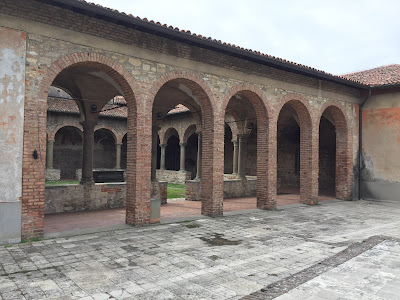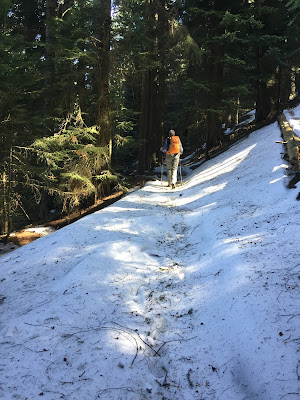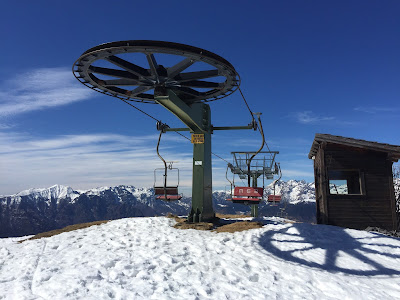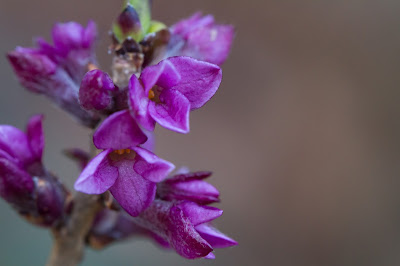
 Left: Path from San Pellegrino Terme to Zogno. Right: Two fellow hikers on Monte Zucco survey San Pellegrino Terme in the Brembana valley.
Overview
Left: Path from San Pellegrino Terme to Zogno. Right: Two fellow hikers on Monte Zucco survey San Pellegrino Terme in the Brembana valley.
Overview
Length: 17 km (11 miles)
Duration: 7 hours moving time, about 9 hours’ (9:30 to 18:20) total time including ½ hour lunch, talking with other hikers, and many flower pictures.
Elevation: 1200 m total gain
Location: Italy, Lombardia, Bergamo, Val Brembana/Val Brembilla
Getting There
We don’t have a car, and therefore, we reach most of our hikes outside of Bergamo by bus, tram, train, or friends with cars. To find the trailhead this time we took a bus from Bergamo to San Pellegrino Terme (of the water fame), in Valle Brembana. We returned to Bergamo from Zogno, a town just a few miles down river from San Pellegrino Terme.
For a summary of hikes around Bergamo and transportation options, see
Walking in Bergamo.
The Walk
Sentiero 506 starts and ends in San Pellegrino Terme, making a loop through the mountains. We followed half of 506, but instead of returning to San Pellegrino Terme, we returned to Zogno via
Sentiero 505B. Along the way, we detoured up to Zucco (1232 m) and ate lunch there enjoying the view. We chatted with two ladies out for the day from Milan which were 2 of the dozen people we encountered today.
Our lunch spot was supposed to be Trattoria Pesenti, but when we called the day before the hike, we were told that they had no cook and wouldn’t be serving lunch the next day. Plan B, a sack lunch looking out over San Pellegrino Terme and the Valle Brembana wasn’t so bad in the end.
After Zucco, we continued on 506 south to Rifugio GESP, turning west and following the trail, which stays more on the ridge of the hill until we reached Catremerio. From there we headed south to the
frazione of S. Antonio Abbandonato. There we stopped for a coffee at a café next to the church. When we walked in, all the locals turned to look at us as we fumbled with backpacks and walking sticks. We sidled up to the bar and ordered. As we sipped our espressos we really felt “watched.” Looking up, we saw what we thought at first was a stuffed owl but turned out to be a real one. The bartender said the owl occasionally makes a flight around the bar. I could think only of talons on my head: time to continue our hike.
Sentiero 505B passes through what are called the
Giardini di pietra (Rock Gardens) so called because of the unusual and striking rock columns found in the area. 505B also passes over a rock formation in the shape of a “W”. It is a layer of rock from the Triassic period called
Calcare di Zu (Zu Limestone).
On the final bit of 505B we came across a large tunnel penetrating into the mountain. We squeezed through the bit of fence barring entry and went for a look. We had a flashlight with us (always in the backpack for hiking), which was necessary as it was pitch dark and had water running through it. The tunnel was large enough to drive a truck through. We descended until we lost sight of the opening and arrived at a huge cavern. We thought it was a quarry but then realized we were in the middle of some kind of transit tunnel piercing through the mountain. We had come in through a service entry. We followed the tunnel to one of its ends (about .5 km). And lucky for us, that’s when we saw the “W” rock formation that we had been walking above earlier. Happy accident.
Turns out the tunnel is a new valley bypass called the “Variante di Zogno”, as it bypasses Zogno center. Due to cost
overruns, it seems the project is on hold for now but due to resume soon.
Flora
It was pleasant hiking weather today: 55 – 60 F, mostly sunny. It seemed like Spring wasn’t far away. On the ground, we were treated to a riot of Easter colors, purples, yellows, rose pinks, and white. The interesting plants on this hike, only because we had never seen them before, were the
Leucojum vernum (Spring snowflake) and
Galanthus nivalis (Snowdrops). Below is a list of the plants that we saw and that were in significant numbers along the trail.
[Family] Genus species – {Common names in English; Italian}
[Amaryllidaceae]
Leucojum vernum – {Spring Snowflake;
Campanellino,
campenelle comuni}
[Amaryllidaceae]
Galanthus nivalis – {Snowdrop;
bucaneve}
[Asparagaceae]
Scilla bifora – {Alpine squill;
Scilla sivestre}
[Asplenianceae]
Asplenium scolopendrium – {Hart’s-tongue fern;
Scolopendria commune}
[Asteraceae]
Tossilago farfara – {Coltsfoot;
Tossilaggine comune}
[Boraginaceae]
Pulmonaria officinalis – {Common Lungwort;
Polmaria maggiore}
[Boraginaceae]
Omphalodes verna – {Creeping Forget Me Not;
Occhi della Madonna primaverili}
[Ericaceae]
Erica carnea – {Winter Heather;
Erica carnicina}
[Ericaceae]
Rhododendron peloso – {Hairy Alprenrose;
Rhododendro peloso}
[Iridaceae]
Crocus spp.
[Liliaceae]
Erythronium dens-canis – {Dog’-tooth-violet; “dente di cane”}
[Primulaceae]
Primula vulgaris – {
Primula comune}
[Ranunculaceae]
Anemone nemorosa – {Wood Anemone;
Anenome bianca}
[Ranunculaceae]
Helleborus niger – {Christmas Rose;
Rosa di natale}
[Ranunculaceae]
Helleborus viridis – {Green Hellebore;
Elleboro verde}
[Ranunculaceae]
Hepatica nobilis – {Common Hepatica, liverwort;
Erba trinità}
[Thymelaeaceae]
Daphne laureola – {Spure Laurel;
Dafne laurella}
For resources consulted to help identify plants, see the post
Resources for Identifying Plants around Bergamo.

 Left: Spores of Asplenium scolopendrium. Right: Pulmonaria officinalis.
Left: Spores of Asplenium scolopendrium. Right: Pulmonaria officinalis.


 Left: Erythronium dens-canis. Center: Daphne laureola. Right: Crocus.
Left: Erythronium dens-canis. Center: Daphne laureola. Right: Crocus.


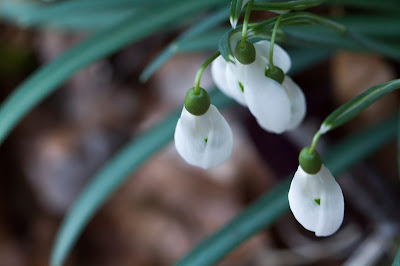 Galanthus nivalis - Snowdrop.
Galanthus nivalis - Snowdrop.


 Green and yellow-tipped Spring Snowflakes, Leucojum vernum.
Green and yellow-tipped Spring Snowflakes, Leucojum vernum.


 Different flower colors of Helleborus niger, Christmas Rose
Different flower colors of Helleborus niger, Christmas Rose

 Left: Helleborus niger flower. Right: Helleborus viridis.
Left: Helleborus niger flower. Right: Helleborus viridis.

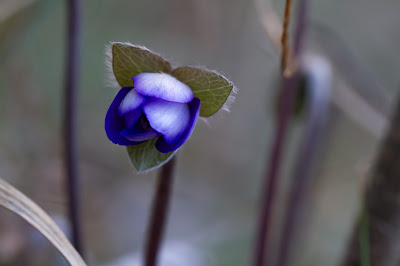
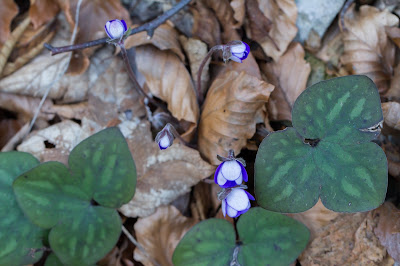 Flowers, bud, and leaves of Hepatica nobilis.
Flowers, bud, and leaves of Hepatica nobilis.
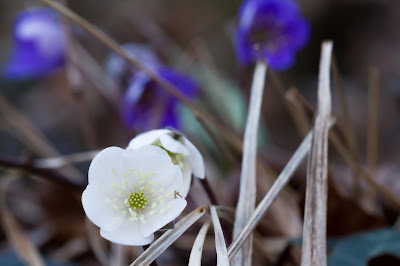
 Left: White Hepatica nobilis. Right: Scilla bifora.
Left: White Hepatica nobilis. Right: Scilla bifora.

 Left: Omphalodes verna. Right: Rhododendron peloso
Left: Omphalodes verna. Right: Rhododendron peloso.

 Left: Primula vulgaris. Right: Tossilago farfara.
Left: Primula vulgaris. Right: Tossilago farfara.


 Left: Start of the hike and coffee at Hotel Moderno. Center: Piazza S. Francesco D'Assisi, the start of the trail. Right: Trail signs for 506 in San Pellegrino.
Left: Start of the hike and coffee at Hotel Moderno. Center: Piazza S. Francesco D'Assisi, the start of the trail. Right: Trail signs for 506 in San Pellegrino.


 Left: Immediately you start climbing from San Pellegrino. Center: The spur out to Monte Zucco. Right: Trail and beech trees near Catremerio.
Left: Immediately you start climbing from San Pellegrino. Center: The spur out to Monte Zucco. Right: Trail and beech trees near Catremerio.


 Left: Heading down to Zogno below S. Antonio Abbondonato. Center: Giardini di pietra (Rock Gardens) above Zogno. Right: Inside Variante di Zogno.
Left: Heading down to Zogno below S. Antonio Abbondonato. Center: Giardini di pietra (Rock Gardens) above Zogno. Right: Inside Variante di Zogno.


